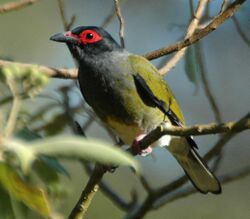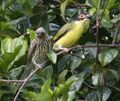Biology:Figbird
| Figbird | |
|---|---|

| |
| Australasian figbird (Sphecotheres vieilloti) | |
| Scientific classification | |
| Domain: | Eukaryota |
| Kingdom: | Animalia |
| Phylum: | Chordata |
| Class: | Aves |
| Order: | Passeriformes |
| Family: | Oriolidae |
| Genus: | Sphecotheres Vieillot, 1816 |
| Type species | |
| Sphecotheres viridis[1] Vieillot, 1816
| |
| Species | |
|
See text | |
| Synonyms | |
| |
The figbirds are a genus (Sphecotheres) in the family of Old World orioles found in wooded habitats in Australia, New Guinea, and the Lesser Sundas.
Taxonomy and systematics
Formerly, the three species have been considered conspecific, but all major authorities now consider them as separate species.[2][3][4][5][6] The split is primarily based on differences in measurements, plumage, and biogeography.
Species
Three species are recognized:[7]
| Image | Common name | Scientific name | Distribution |
|---|---|---|---|
| Green figbird | Sphecotheres viridis | Indonesian islands of Roti and Timor | |
| Wetar figbird | Sphecotheres hypoleucus | Indonesian island of Wetar | |
 |
Australasian figbird | Sphecotheres vieilloti | northern and eastern Australia, southern New Guinea, and the Kai Islands |
Description
They are strongly sexually dimorphic, with males having olive-green upperparts, a black head, and (uniquely for the family) distinct bright red facial skin.[8][9] Females are drab-coloured, being dull brownish above, and white below with strong dark streaking. They have greyish facial skin, and a greyish-black bill.[8][9]
Behaviour and ecology
Compared to the "typical" Old World orioles of the genus Oriolus, the figbirds are more frugivorous (though they also take some small insects, nectar, and seeds) and gregarious, even breeding in small, loose colonies (at least for the Australasian figbird; the nesting habits are still unknown for the other two species).[2]
References
- ↑ "Oriolidae". The Trust for Avian Systematics. https://www.aviansystematics.org/4th-edition-checklist?viewfamilies=146.
- ↑ 2.0 2.1 Higgins, P. J., L. Christidis, & H. A. Ford (2008). Family Oriolidae (Orioles). Pp. 692-731 in: del Hoyo, J., A. Elliott, & D. A. Christie. eds. (2008). Handbook of the Birds of the World. Vol. 13. Pendulin-tits to Shrikes. Lynx Edicions. ISBN:978-84-96553-45-3
- ↑ Dickinson, E. C. (editor) (2003). The Howard and Moore Complete Checklist of the Birds of the World. 3rd edition, w. updates. Christopher Helm. ISBN:0-7136-6536-X
- ↑ Andrew, P. (1992). The Birds of Indonesia: A Check-list. Kukila Check-list No. 1. Indonesian Ornithological Society, Jakarta.
- ↑ Gill, F., M. Wright, & D. Donsker (2009). IOC World Bird Names. Version 2.1. Accessed 04-07-2009
- ↑ Christidis, L., & W. E. Boles (2008). Systematics and Taxonomy of Australian Birds. CSIRO. ISBN:978-0-643-06511-6
- ↑ "Orioles, drongos & fantails « IOC World Bird List" (in en-US). http://www.worldbirdnames.org/bow/orioles/.
- ↑ 8.0 8.1 Simpson, K. (editor) & N. Day (illustrator) (1994). Field Guide to the Birds of Australia. 2nd edition. Christopher Helm. ISBN:0-7136-3930-X
- ↑ 9.0 9.1 Coates, B. J., & K. D. Bishop (1997). A Guide to the Birds of Wallacea. Dove Publications Pty. Ltd. ISBN:0-9590257-3-1
Wikidata ☰ Q2417877 entry
 |

